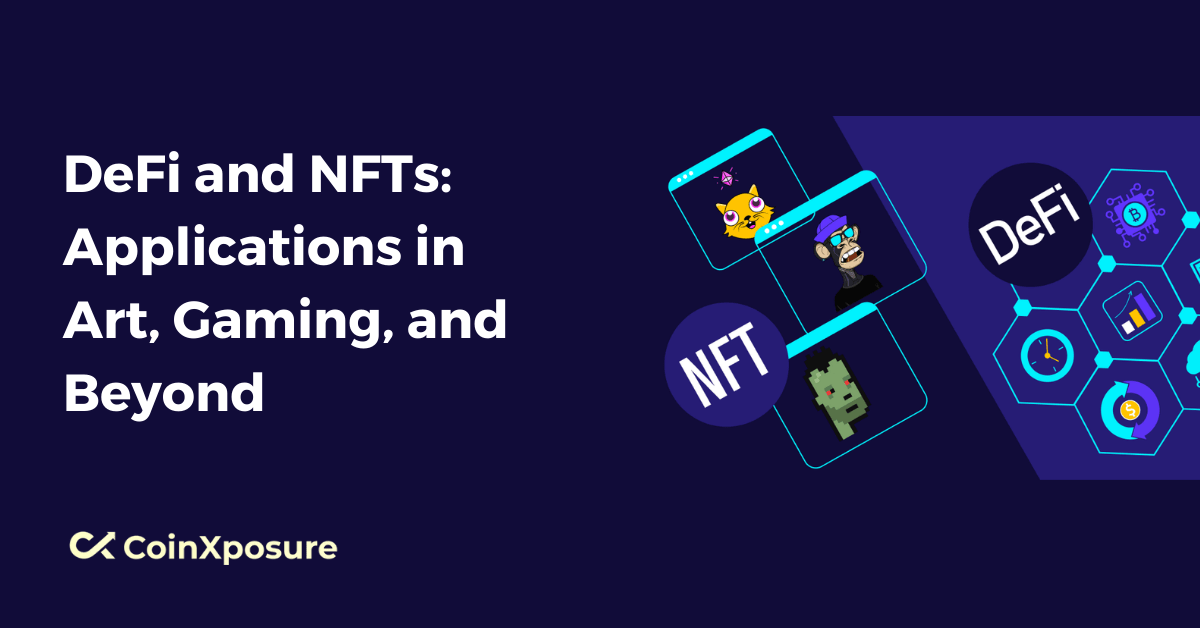Decentralized Finance (DeFi) and Non-Fungible Tokens (NFTs) have emerged as disruptive technologies revolutionizing traditional finance, art, gaming, and beyond.
DeFi refers to a decentralized ecosystem of financial applications built on blockchain technology, offering innovative solutions for lending, borrowing, and trading without intermediaries.
On the other hand, NFTs represent unique, indivisible, and irreplaceable digital assets, enabling ownership and provenance verification in a digital realm.
In this article, we will explore the diverse applications of DeFi and NFTs, focusing on their transformative impact in art, gaming, and various other sectors.
DeFi Applications
DeFi (Decentralized Finance) has been transformative in various financial sectors, offering numerous applications that challenge traditional finance. Here are some key DeFi applications:
- Decentralized Exchanges (DEXs)
- Lending and Borrowing Platforms
- Yield Farming and Liquidity Mining
- Stablecoins
Decentralized Exchanges (DEXs)
DEXs enable users to trade cryptocurrencies and tokens directly with one another without the need for intermediaries like centralized exchanges. Examples include Uniswap, SushiSwap, and PancakeSwap.
Lending and Borrowing Platforms
DeFi platforms allow users to lend their cryptocurrencies and earn interest or borrow assets using their existing holdings as collateral. Platforms like Compound and Aave facilitate these peer-to-peer lending and borrowing transactions.
Yield Farming and Liquidity Mining
Yield farming involves providing liquidity to DeFi protocols in exchange for rewards, typically as additional tokens. Liquidity mining incentivizes users to contribute liquidity to DeFi platforms, thereby enhancing liquidity pools and ecosystem growth.
Stablecoins
Stablecoins are cryptocurrencies pegged to fiat currencies or other assets, providing stability in volatile crypto markets. DeFi has popularized the use of stablecoins like USDT, USDC, and DAI for trading, lending, and other financial activities.
These DeFi applications provide users with greater financial autonomy, transparency, and efficiency compared to traditional finance.
However, they also come with risks such as smart contract vulnerabilities, regulatory uncertainty, and potential for market manipulation, highlighting the importance of due diligence and risk management in the DeFi space.
NFT Applications
Non-Fungible Tokens (NFTs) have gained popularity for their ability to represent unique digital assets and establish ownership on the blockchain. Here are some key applications of NFTs:
- Digital Art Ownership
- Tokenized Collectibles
- Dynamic and Programmable Art
- Gaming Assets and Virtual Worlds
Digital Art Ownership
NFTs enable artists to tokenize their digital artwork, creating unique digital assets that can be bought, sold, and traded on NFT marketplaces.
This allows artists to establish ownership, authenticity, and provenance for their creations, while also providing a new revenue stream through sales and royalties.
Tokenized Collectibles
NFTs have revolutionized the concept of collectibles by allowing users to tokenize and trade unique digital items such as virtual trading cards, digital fashion items, and virtual real estate.
Platforms like NBA Top Shot and CryptoKitties have popularized the concept of digital collectibles, attracting collectors and enthusiasts alike.
Dynamic and Programmable Art
NFTs offer programmable features that enable dynamic and interactive digital art experiences.
Artists can create NFTs with embedded functionality, such as unlockable content, interactive elements, and royalties mechanisms, adding new dimensions to the art ownership experience.
Gaming Assets and Virtual Worlds
NFTs transform the gaming industry by enabling true ownership of in-game assets and virtual items.
Players can buy, sell, and trade NFT-based items within games and virtual worlds, creating vibrant player-driven economies. Projects like Axie Infinity and Decentraland are leading the way in integrating NFTs into gaming experiences.
These applications demonstrate the versatility and potential of NFTs beyond digital art and collectibles, unlocking new possibilities for ownership, commerce, and creativity in the digital age.
However, challenges such as scalability, interoperability, and regulatory considerations remain important to address as the NFT ecosystem evolves.
Challenges and Future Outlook of DeFi and NFTs
Challenges and future outlooks of DeFi and NFTs applications:
- Scalability
- Environmental Concerns
- Regulatory Uncertainty
- Interoperability and Standardization
Scalability
Both DeFi and NFT ecosystems face scalability challenges, with high gas fees and network congestion hindering the scalability of blockchain platforms like Ethereum.
Solutions like layer 2 scaling solutions and alternative blockchains are being developed to address these issues and improve scalability.
Environmental Concerns
The energy consumption of blockchain networks, particularly proof-of-work consensus mechanisms like Ethereum’s, has raised environmental concerns.
Transitioning to more energy-efficient consensus mechanisms or implementing sustainability initiatives within the blockchain ecosystem is essential to mitigate environmental impacts.
Regulatory Uncertainty
DeFi and NFTs operate in a rapidly evolving regulatory landscape, with authorities worldwide grappling to establish clear regulations.
Regulatory clarity is crucial to foster innovation and ensure consumer protection, but overly restrictive regulations could stifle growth and innovation in the space.
Interoperability and Standardization
Achieving interoperability between different DeFi protocols and NFT marketplaces is essential for seamlessly transferring and exchanging assets across platforms.
Standardization of protocols, formats, and metadata is also needed to improve usability and interoperability within the ecosystem.
Addressing these challenges will be crucial to realizing the full potential of DeFi and NFTs, unlocking new possibilities for decentralized finance, digital ownership, and creative expression in the years to come.
As the ecosystem matures and evolves, collaboration between industry stakeholders, regulators, and users will be essential to navigate challenges and foster sustainable growth and innovation in the DeFi and NFT space.
Conclusion
DeFi and NFTs represent groundbreaking innovations that are reshaping traditional finance, digital ownership, and creative expression.
DeFi applications offer decentralized financial services that empower users with greater control, transparency, and accessibility. At the same time, NFTs enable the tokenization and ownership of unique digital assets, revolutionizing art, gaming, and beyond.
Despite facing challenges such as scalability, regulatory uncertainty, and security risks, the future outlook for DeFi and NFTs is promising.
Continued innovation, technological advancements, and ecosystem developments are driving the evolution of these technologies, opening up new opportunities for financial inclusion, digital commerce, and cultural expression.
DeFi and NFTs are not just trends, but rather fundamental shifts in how we think about finance, ownership, and creativity in the digital age.
By navigating challenges and embracing opportunities, we can unlock the full potential of DeFi and NFTs to create a more decentralized, inclusive, and innovative future.












